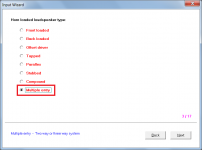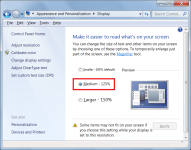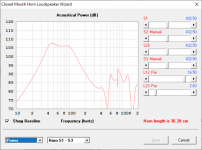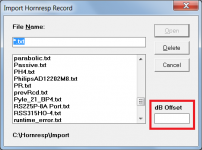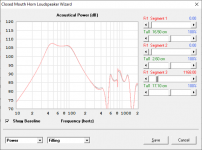BP6
Thanks
Hello
BP6 is an enclosure which has two chambers. First chamber is bigger and tuned to lower frequency, second chamber is smaller, and tuned to higher frequency. tuning frequency of first chamber is near to frequency of the second chamber. The two resonant peaks of each chamber add up and form an even frequency response between the tuning frequencies.
Regards,
Artem
Thanks
hello I NEED HELP TO LEARN TO SIMULATE A SYNERGY HORN, I HAVE A 4X8 "AND 4X6" OUTLINE AND A 2 "THROAT CD ... COULD YOU HELP ME?
I NEED HELP TO LEARN TO SIMULATE A SYNERGY HORN
The easiest way to get started is to create an appropriate multiple entry horn "template" using the Input Wizard, and to then alter the input parameter values to suit your specific design. Also, read the "Two-Way or Three-Way Multiple Entry Horn" section in the Help file.
Attachments
David thank you very much for your attention; I have a lot to learn from you. would you like to create a short tutorial on this using HP?
would you like to create a short tutorial on this using HP?
Hi Robson,
Providing the Input Wizard and the Help file information is the best that I can do. It takes up all my time just maintaining Hornresp.
I have to leave the creation of tutorials to others...
Kind regards,
David
would you like to create a short tutorial on this using HP?
just do a quick internet-search and you will find lots of tutorials, even from brazil:
Tutorial Hornresp - YouTube
Hornresp Update 5220-210501
Hi Everyone,
CHANGE 1
Previously it was not possible to switch a BP6 or BP8 design from series to parallel in the loudspeaker wizard if a passive radiator had been specified. This restriction has been relaxed so that it now only applies to a BP6 parallel design with a passive radiator at port 2.
CHANGE 2
The different topology for an offset driver / offset port system with closed rear chamber requested by Brian in Post #11959 has now been implemented. Either a port tube or a passive radiator can be specified - see Attachments 1 and 2. The modified topology applies to three segment systems only.
CHANGE 3
Port 1 in a BPB design can now be replaced by a passive radiator, as requested by Artem in Post #12052. Attachment 6 refers.
CHANGE 4
Impulse response data can now be exported as either a 16-bit integer or 32-bit floating point PCM wave sound file. Attachment 7 refers.
My thanks to bolserst for providing the necessary 32-bit file format details.
CHANGE 5
Previously, when components were omitted from a loudspeaker design, gaps were left in the system model acoustic circuit diagram. Except for tapped and multiple entry horns, this is no longer the case. For example, Attachment 8 shows the old system model diagram for a stubbed horn SH2 design with throat chamber and absorber chamber port tube omitted. Attachment 9 shows the new diagram.
BUG FIX
The electrical impedance was not being shown correctly when the lossy inductance option was selected in an offset driver / offset port type design (Posts #11968 and #11969 refer). This has now been fixed.
My thanks to freddi and Brian for identifying the problem and for bringing it to my attention.
Kind regards,
David
Hi Everyone,
CHANGE 1
Previously it was not possible to switch a BP6 or BP8 design from series to parallel in the loudspeaker wizard if a passive radiator had been specified. This restriction has been relaxed so that it now only applies to a BP6 parallel design with a passive radiator at port 2.
CHANGE 2
The different topology for an offset driver / offset port system with closed rear chamber requested by Brian in Post #11959 has now been implemented. Either a port tube or a passive radiator can be specified - see Attachments 1 and 2. The modified topology applies to three segment systems only.
CHANGE 3
Port 1 in a BPB design can now be replaced by a passive radiator, as requested by Artem in Post #12052. Attachment 6 refers.
CHANGE 4
Impulse response data can now be exported as either a 16-bit integer or 32-bit floating point PCM wave sound file. Attachment 7 refers.
My thanks to bolserst for providing the necessary 32-bit file format details.
CHANGE 5
Previously, when components were omitted from a loudspeaker design, gaps were left in the system model acoustic circuit diagram. Except for tapped and multiple entry horns, this is no longer the case. For example, Attachment 8 shows the old system model diagram for a stubbed horn SH2 design with throat chamber and absorber chamber port tube omitted. Attachment 9 shows the new diagram.
BUG FIX
The electrical impedance was not being shown correctly when the lossy inductance option was selected in an offset driver / offset port type design (Posts #11968 and #11969 refer). This has now been fixed.
My thanks to freddi and Brian for identifying the problem and for bringing it to my attention.
Kind regards,
David
Attachments
-
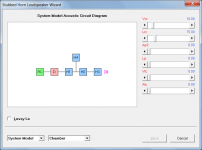 Attach_9.png44.1 KB · Views: 107
Attach_9.png44.1 KB · Views: 107 -
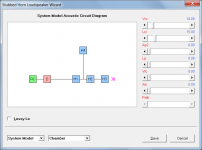 Attach_8.png45.9 KB · Views: 103
Attach_8.png45.9 KB · Views: 103 -
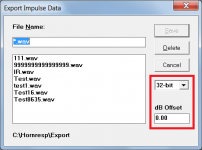 Attach_7.png26.2 KB · Views: 109
Attach_7.png26.2 KB · Views: 109 -
 Attach_6.png46.7 KB · Views: 106
Attach_6.png46.7 KB · Views: 106 -
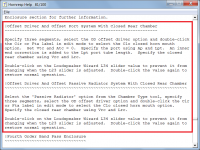 Attach_5.png69.6 KB · Views: 98
Attach_5.png69.6 KB · Views: 98 -
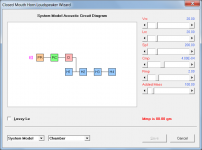 Attach_4.png46.1 KB · Views: 189
Attach_4.png46.1 KB · Views: 189 -
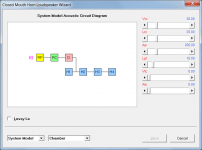 Attach_3.png45.4 KB · Views: 220
Attach_3.png45.4 KB · Views: 220 -
 Attach_2.png46.3 KB · Views: 219
Attach_2.png46.3 KB · Views: 219 -
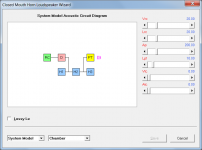 Attach_1.png44.8 KB · Views: 229
Attach_1.png44.8 KB · Views: 229
if I do an impulse export and import it into REW, it is about 23dB higher than reference.
Does using the new 32-bit export option, with appropriate dB offset value, fix the problem?
CHANGE 2
The different topology for an offset driver / offset port system with closed rear chamber requested by Brian in Post #11959 has now been implemented. Either a port tube or a passive radiator can be specified - see Attachments 1 and 2. The modified topology applies to three segment systems only.
Sweet! I might finally be able to solve the "Enigma" issue, i.e. what's the perfect port size and length for an offset 4th order BP system in order to ensure that out-of-band resonances are minimized as much as possible.
Hi Robson,
Providing the Input Wizard and the Help file information is the best that I can do. It takes up all my time just maintaining Hornresp.
I have to leave the creation of tutorials to others...
Kind regards,
David
ok, David, thank you very much, I know that the creation of HP takes you all the time, and that enchants me with your willingness to help us all .... I will endeavor to create some tutorials to help many with my doubts. ..
I might finally be able to solve the "Enigma" issue
Please let us know if you are successful in doing so.
Anyway to enlarge HR to where I can see it better?
Hi GM,
I don't know what the equivalent would be in Windows 10, but in Windows 7 I use the Medium (125%) Text setting to enlarge Hornresp to the size I want.
To set the text size in Windows 7: Control Panel > Appearance and Personalization - Adjust screen resolution > Change the appearance of your display - Make text and other items larger or smaller > Medium - 125% > Apply.
(I use a display resolution of 1600 x 900 pixels).
Kind regards,
David
Attachments
Last edited:
I use 150% in W10 on my home laptops and desktop. I use 175% on my work laptop. All with 1080p HD. The work laptop is connected to 2 x 27" monitors in the office and a 55" 4K TV at home.
Last edited:
David
Greets!
Cool! Learn something new everyday! Thanks!

This HP ProBook came with 7 pro 64? and a then just released W10 disc. For regular viewing I uses 125% also. I've no idea what the resolution is, but definitely not HD and with my vision a waste of $$ except when setting close to big 4k TVs.
edit: resolution's maxed out at 1366 x 768.
Last edited:
Please let us know if you are successful in doing so.
I'm happy report that, by using the updated Hornresp model, the corresponding response predictions from Hornresp are the closest that I've ever seen to the measured performance of the Enigma 🙂
This bodes well, because it suggests that it might actually be possible to use Hornresp to design a 4th order BP system with minimized out of band noise, and the measurements will be pretty close to the sim'd performance.
I'm happy to also say that the new model also gives me some ideas of how the Enigma's performance can be improved even further, as the sim suggests that the box is still tuned a little low. Maybe it's time for Enigma v2 🙂.
Now, if only Hornresp would also accept filling data from the BOXPLAN import file... 🙂
Attachments
the corresponding response predictions from Hornresp are the closest that I've ever seen to the measured performance of the Enigma 🙂
Excellent, thanks for the feedback.
Now, if only Hornresp would also accept filling data from the BOXPLAN import file... 🙂
That would mean modifying the format of the BOXPLAN import file, which could cause problems for us both. I would not want to have two different versions of the file in use (ie. one with, and one without, filling data). Also, the filling would not apply to BP type cabinets.
At the moment filling can be specified in the Loudspeaker Wizard and adjusted there as necessary as each refinement to a BOXPLAN design is imported using F6. The final optimised design settings can then be saved to the permanent Hornresp record.
This new model allows me to include the effects of filling though (see attached).
No biggie. The way I'd probably approach it is to ignore filling data if not included in the import file, but it's no real biggie - it's easy enough to adjust in the Loudspeaker Wizard anyway.
No biggie. The way I'd probably approach it is to ignore filling data if not included in the import file, but it's no real biggie - it's easy enough to adjust in the Loudspeaker Wizard anyway.
Attachments
The way I'd probably approach it is to ignore filling data if not included in the import file
I experimented with importing filling data from BOXPLAN but I don't like the functionality 🙂.
After adjusting the filling values in the loudspeaker wizard to optimise the performance for a given set of cabinet dimensions, importing a design iteration using F6 sets the filling sliders back to the BOXPLAN values. I find it much easier to use if the filling sliders remain as previously adjusted. Trying to "guess" the correct filling values to enter into BOXPLAN to then import into Hornresp for a given design iteration is virtually impossible.
In other words, it's not going to happen 🙂.
- Home
- Loudspeakers
- Subwoofers
- Hornresp
